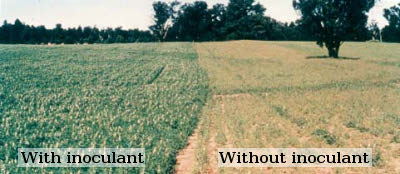
Types of legume inoculants
 Scientists
have discovered that inoculating legumes with nitrogen-fixing bacteria
can increase crop yields. The theory is simple --- if your plants
lack the proper bacteria to team up with, they're stuck begging ammonia
out of the soil rather than producing their own.
Scientists
have discovered that inoculating legumes with nitrogen-fixing bacteria
can increase crop yields. The theory is simple --- if your plants
lack the proper bacteria to team up with, they're stuck begging ammonia
out of the soil rather than producing their own.
But you can't just
inoculate your entire garden with one kind of
bacterium and be done with it. Most plants that team up with
nitrogen-fixing bacteria are picky about the bacteria species they move
in with. Clovers share one set of bacteria species, garden and
soup beans another, and alfalfa, soybeans, peanuts, clover, and peas
each have their own. You can often buy seeds already coated in
the proper inoculant, or can even transplant a bit of soil from your
previous pea patch to your new one to get the useful bacteria started.
As a side note, I was
intrigued to learn that legumes aren't the only
plants that team up with nitrogen-fixers. The other common,
nitrogen-fixing plant in our area is the shrub alder (Alnus
sp.) I've been keeping an eye out for some wild alders to
transplant into my forest
garden as a method
of naturally boosting the
area's fertility.
| This post is part of our Nitrogen Fixing lunchtime series.
Read all of the entries: |
Want more in-depth information? Browse through our books.
Or explore more posts by date or by subject.
About us: Anna Hess and Mark Hamilton spent over a decade living self-sufficiently in the mountains of Virginia before moving north to start over from scratch in the foothills of Ohio. They've experimented with permaculture, no-till gardening, trailersteading, home-based microbusinesses and much more, writing about their adventures in both blogs and books.
Want to be notified when new comments are posted on this page? Click on the RSS button after you add a comment to subscribe to the comment feed, or simply check the box beside "email replies to me" while writing your comment.
- Remove comment
- Remove comment
- Remove comment
- Remove comment
